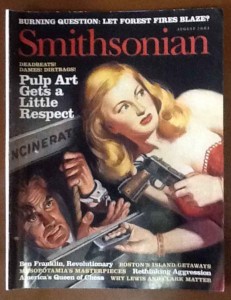You know, I had two whole paragraphs written and it read like self indulgent rubbish so I’ve just deleted every word and I’m going to write about a magazine I picked up an an op shop a while ago. It’s called the Smithsonian and is published by the Smithsonian Institute in Washington. The Smithsonian had an interesting start it was funded by a bequest by a British Scientist, James Smithson, who’d never been to America and stipulated the money should go to his nephew but if he died without heirs the money should then go to the United States to set up a Smithsonian Institute in Washington. There are now 18 museums in the Smithsonian as well as a number of affiliates around the world.
The magazine has a lot of interesting articles and I’ve read it from cover to cover. What brought my attention was the cover article about cover art for pulp magazines. As you may have guess if you’ve been reading here long enough is that pulp magazines are very dear to my heart, many writers and many artists got their start writing and drawing for pulp magazines. This article makes it clear that many artists learned their drawing on the job, some of them were given a story and requested to give it decent cover art while others handed in artwork which was then given to a writer who’d be asked to write a story to go with it.
Some of the art work was really great and if you look at the photo below you’ll see what I mean. It shows a man in an incinerator holding onto a rope, holding his hand out for the gun the beautiful girl is giving him, the handcuffs intrigue me.

Many ‘real’ artists of the time felt this work demeaning so they threw the original out as soon as it was used, very little original cover art was kept so what little was kept is now worth quite a lot of money. Many of them are unsigned as
artists trained in the finest arts schools in the country considered this a lowbrow activity.
Ernest Chiriacka painted hundreds of covers for magazines such as Dime Western Magazine in the 1940s sometimes signing them “E.C.” but mostly leaving them unsigned
“I was ashamed of them,” he confesses.
The art was masterful and hardly subtle with bold brushstrokes, colours raw and saturated.

